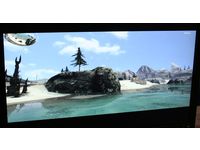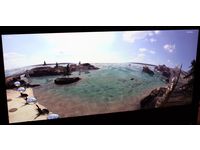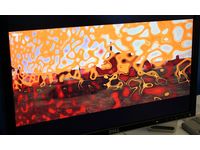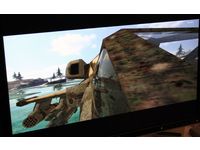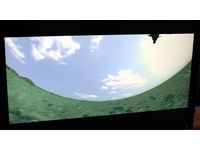Intel Converts ET: Quake Wars To Ray-tracing
Mountain View (CA) - Up until yesterday, Intel was showcasing its ray-tracing research using Quake 3 and Quake 4, which were nice demos, but did not exactly reflect fresh software. Over past several months, the company has been working one converting Enemy Territory: Quake Wars and we have to admit that the results are quite impressive.
Intel demonstrated ET: Quake Wars running in basic HD (720p) resolution, which is,a ccording to our knowledge, the first time the company was able to render the game using a standard video resolution, instead of 1024 x 1024 or 512 x 512 pixels. Seeing ETQW running in 14-29 frames per second in 1280x720 has brought up our hopes for Intel’s CPU architecture, since we do not believe that CPUs would deliver a similar performance when rasterizing graphics. For the record, the demonstration ran on a 16-core (4 socket, 4 core) Tigerton system running at 2.93 GHz.
The game itself was vastly expanded when compared to original title. Intel’s Daniel Pohl showed how the engine now shoots three million rays in all directions, enabling collision detection based on rays alone.
Also, during the conversion, some effects were integrated by default, even if they had not been planned. One of those effects was fog shadow on the floor and physically-correct refractions of water. If you ever dived into a swimming pool or sea and looked up, you could have seen that the world is distorted. Now, ET: Quake Wars has the very same effect.
An impressive part of demonstration was looking at glass surfaces. Glass now reflects the environment to the tiniest detail - no LOD trickery here. Seeing a 200-window portal was quite an impressive demonstration of a situation when you are shooting rays into the environment. Check out our gallery to get more detail on this demo.
The icing on the cake was that the game was actually demonstrated running on a 64-bit Linux operating system. Intel stated that with ray-tracing, the company now supports 32-bit and 64-bit versions of Linux and Windows operating systems. We’ll see what will happen with Mac OS X support, but that should be on the cards as well.
Get Tom's Hardware's best news and in-depth reviews, straight to your inbox.
-
ahmshaegar Awesome. I wonder how physically accurate the models are. Since the article mentions refraction as an example, does the game include a table of indices of refraction for various materials? Will there be total internal reflection when under water for the critical angle and larger angles? Will light obey the Fresnel equations? Will the reflectivity of glass depend on the angle of incidence? I'm curious. Of course, people don't really pay attention to these effects. Have any of you noticed that glass is more reflective at extreme angles (or that this reflected light is polarized -- and yes, humans can detect polarized light. It's called Haidinger's brush.)Reply
Anyway, excellent achievement. This is a game, so getting it running in real-time is infinitely more important than being physically accurate. Reason I said all that was it annoys me when some of the gamers talk about physics in games when physics in games is just full of fudge factors meant to make the game behave well enough. -
JeanLuc Nice, they only downer is that you need a 4 core 4 CPU setup, lol.Reply
To be fair I don't think this is to far away in 2010 Intel's Sandy Bridge could be touting 32 cores which if you combine that with CPU architecture improvements plus video card development Ray tracing could be a real possibility in a couple of years time.
-
wow... they really need to edit this... i'm sorry toms i don't care if you get upset with me... but you are a top site... and for you to make obivous mistakes such asReply
"but did not exactly reflect fresh software. Over past several months, the company has been working one converting Enemy Territory: Quake Wars and we..." one... come on... who makes that mistake even if you proof read it how do you miss that...
another one
"resolution, which is,a ccording to our knowledge," a ccording to my knowledge there isn't a space in according... i've read several toms hardware articles lately and I like the info and content... but EVERY SINGLE article i have read has had an error... its ridiculous
-
terror112 Now what If you ran ray tracing on the next-gen cards that are theoretically capable of 1+ teraflops.Reply -
lordmetroid If you look at the anansi model closeup screenshot, you will notice that there are no bump maps added to this. A downer in my opinion, bump maps are crucial for the graphical experience.Reply
Can't wait until We have many-core cpus available. Should definitely speed things up dramatically and so many possibilities! -
SirCrono terror112Now what If you ran ray tracing on the next-gen cards that are theoretically capable of 1+ teraflops.It would suck as GPUs aren't made to do the kind of math that ray tracing require.Reply
The pics looks nice btw.
Oh and Theo, if you press F7 in Word it'll correct your mispelliin, it's quite useful I might add. -
fransizzle It really is amazing to me how much light filters and shaders have evolved in the pat few years, and what a big impact on the visuals in a game it has. Ray tracing is the next step in that evolution,and I can't wait. Some of the current ray traced images you can find online are simply photo realistic.Reply -
mr roboto It looks amazing but do they have to put those damn orbs in every demo? I mean how many retail games are going to use reflective orbs in every level? Also this looks like it's only partially RayTraced compared ro the Quake III demo. So two Skulltrail systems should do it? No problem.Reply -
hannibal Very smal resolution and not so speedy at this moment, but yes in the future raytracing can be reasonable alternative to raster / shader based games. Exspecially if you have small 14-15 inch monitor with low resolution.Reply
Does anyone know if it's possible to combine raytraced objects with rasters?
